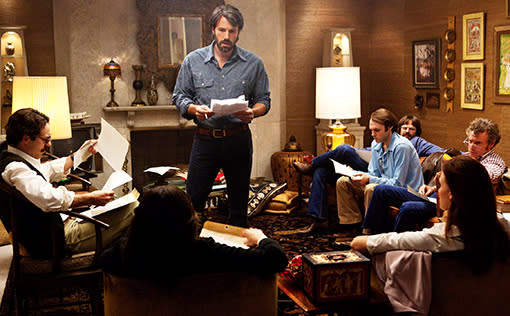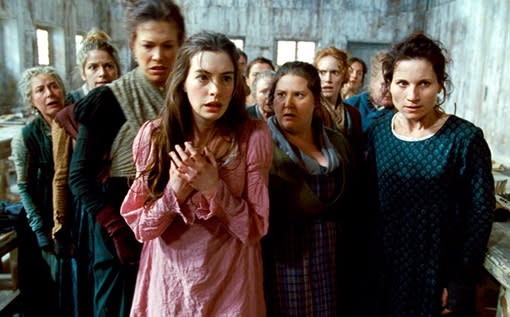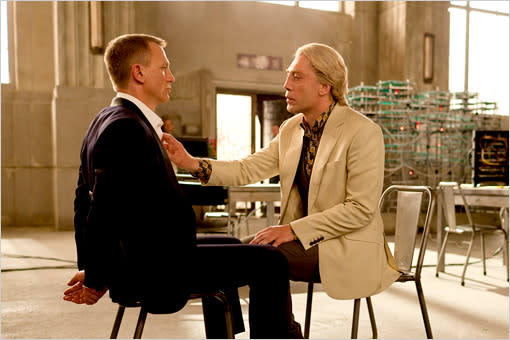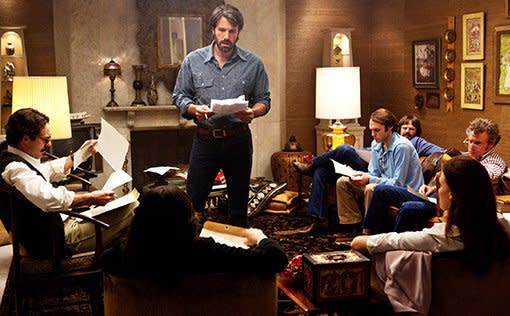Oscars: Sound Mixing 101
Leading up to Sunday’s Oscars, EW.com will take a closer look at four categories that moviegoers may mistakenly think of as “technical.” After tackling Film Editing and Sound Editing, we now turn to Sound Mixing, with insights from nominees from Les Misérables, Skyfall, and Argo. Lincoln and Life of Pi complete the category. (Update: Cinematography completes this series.)
“The biggest misconception about what we do is that most people think it’s technical in nature because there’s intimidating mixing consoles involved. In reality, we are extremely creative in the use of sound to help tell the story,” says Argo sound re-recording mixer Gregg Rudloff, a five-time Oscar nominee with wins for his work on Glory and The Matrix. “But it goes back to what do you want people to notice and not notice? We want them to be watching the film and experiencing it and enjoying it. We don’t want them to be sitting there going, ‘Oh wow, that was a really cool sound thing that guy just did there.’ We don’t want to put them back in their seats. We want them to be totally immersed in the film. So in a way, we’re our own worst enemies. If we do a bad job, people notice what we do, and that’s not what we want. If we do it really well, people don’t notice it so much, but then they don’t understand the depths we’re working at.”
To fix that problem, we asked some of this year’s sound mixing nominees to walk us through key scenes to explain their roles and show us the kind of decisions their making. But first, the difference between sound mixing and sound editing, a separate Oscar category.
Essentially, the sound editorial team is responsible for assembling every sound you hear in the movie except the music and the dialogue that was recorded on set.
It’s the job of the production sound mixer to capture that dialogue as cleanly as possible to preserve the actor’s original performances, so sound editorial doesn’t have to have them do ADR (Automated Dialogue Replacement). Post-production, the sound mixing team takes all the material that has been prepared by sound editorial — dialogue, atmospheric sounds like the wind and ocean; hard effects, which are synched sounds for things like cars, gunshots, explosions, and helicopters; and Foley, or nuance sounds such as footsteps and people touching things with their hands — plus the score, and affixes them to the screen and positions them in the theater while also setting their volume levels relative to each other. “We get tens of thousands of pieces of sound in a film. It’s like a big chemistry set: How much of this do you put in to that? And how much of this do you put in to that, and how will that affect this?” says Skyfall re-recording mixer Scott Millan, whose nine Oscar nominations include four wins for his work on Apollo 13, Gladiator, Ray, and The Bourne Ultimatum. “All of us who do this work have a sensitivity and a touch that’s pretty unique. If you gave the same content to 10 individuals and said go ahead and mix this movie, you’d get 10 different perspectives. They wouldn’t be the same. And that’s what’s so much fun about it. It’s almost like handing sheet music to a bunch of musicians: How they touch it, and how they touch it collectively together as an ensemble, is unique. If you change any of those players, it would be different yet again. “
Since it all starts with the dialogue captured on set, let’s begin there.
NEXT: The art of production sound mixing

“The production sound mixer on any show is responsible for preserving the actors’ original performances and making sure that the feelings and the emotions during a scene on set are carried all the way through from the production process into the post-production process,” says Les Misérables’ production mixer Simon Hayes, a first-time Oscar nominee. “If the production sound mixer has done a good job, and recorded so perfectly that background noise won’t become an issue, that is the performance you see on-screen in the cinema.”
With director Tom Hooper deciding to have his actors sing live on set — piano players played in their earpieces, allowing the actors to dictate tempo — Les Misérables is obviously a showcase for the crucial role the production sound mixer plays. Hayes points to the scene in which Eponine (Samantha Barks) is walking down Rue Plumet singing “On My Own” in the rain.
undefined
Though Anne Hathaway was stationary for “I Dreamed a Dream,” it presented its own challenge:
undefined

Hathaway’s factory number “At the End of the Day” was challenging because it involved blending her voice with 25 other women’s, Hayes says. “We were trying to be sure that Annie’s came through and every word of hers could be heard, but also that the other girls were beautifully recorded as well. And so we were really like artists playing with a palette of colors.”

Argo’s production sound mixer, first-time nominee Jose Antonio Garcia also had an added challenge because he and director Ben Affleck decided to let actors overlap on dialogue. “When you’re shooting a single of an actor, off-camera people generally have to wait for them to deliver the line, so the dialogue on-screen is cuttable. Then there’s no actor on top of him that would force you to use that overlap. Ben and I discussed it, because once you allow that you are married to that overlap, and we basically mic’d everybody at all times,” Garcia says. “That gave the performance a higher level of realism.”
NEXT: The art of the final mix

Usually, the re-recording mixers (one typically handles the dialogue and music, and the other sound effects) will do a broadstroke first pass on the director’s first cut of the film independently of the director. “It’s what we think things will play like and what content we need in the film. Yet, we keep it all very separate, so that the choices can be changed when the filmmaker arrives,” says Skyfall’s Millan, who shares his nomination with re-recording mixer Greg P. Russell, a 16-time Oscar nominee, and twice nominated production sound mixer Stuart Wilson.
Once it’s time for the final mix, it’s a serious group effort. “When we get to the final, we have the director with us on stage, the sound editorial supervisor — the person who is responsible for assembling, finding, and creating all the sounds that we would ultimately be dealing with in the mixing process — almost always the picture editor, and often the sound editors as well. We’ll have the dialogue editor and the sound effects editor there,” Millan says. “Because of the parallel process of finishing films now — meaning the schedule’s so compressed and the picture is changing as we are in the process of making our final mix — things have to be more virtual than ever before. Even though we’ve created material that we thought was appropriate, the filmmaker may have another choice, or a visual effect may have changed or have been added that we didn’t know about. So there’s this constant evolution during the final mix of creating and integrating new content into the pre-dubbed material. “
Millan has worked on every one of director Sam Mendes’ films, so he understands and appreciates the director’s sensibilities when it comes to using sound to help tell the story. “The slightest nuance of the tone of a voice or the subtlety of a performance and how it might be dynamically supported is important to him,” Millan says. He points to the memorable scene in which Bond (Daniel Craig) and Silva (Javier Bardem) first come face-to-face.
undefined
Another example is one of Millan’s favorite moments from Mendes’ second movie, Road to Perdition.
undefined
NEXT: The art of Argo‘s tension

How many times have you heard someone say, “I was on the edge of my seat, and I knew what was going to happen” after seeing Argo. When something works that well, it starts with great writing, continues with great acting, directing, and picture editing, and ends with great sound. The Oscar-nominated sound editors took us through key scenes here. Now re-recording mixer Rudloff, who shares his nomination with production sound mixer Garcia and fellow re-recording mixer John Reitz, a five-time Oscar nominee with a win for The Matrix, tells us how they created that tension.
First, the scene after the prologue:
undefined
Throughout the film, Affleck had been trying to reinforce that the American houseguests were surrounded in a foreign land. It crescendos with the climactic airport finale.
undefined
How do sound re-recording mixers know when they’re ready to sign off on a scene like that? “When Ben says it’s done,” Reitz says. “When he’s happy with a scene, then we concentrate on the next one. That’s just the way it is.” Says Rudloff: “I asked the same question when I first started mixing. I used to say, ‘How do you know when it’s right?’ Over time, you learn you just have a feeling when it’s working. Unfortunately, there’s not a list of criteria you can point to and say, ‘Well, as long as I’ve done A, B, and C, we’re done.’ There’s always something else you can do. It’s subjective. It’s creative. You can always try something else. Like John says, ‘When the director says we’re done, we’re done.'”
Read more:
Oscar-nominated cinematographers explain how they envelop you in the story


